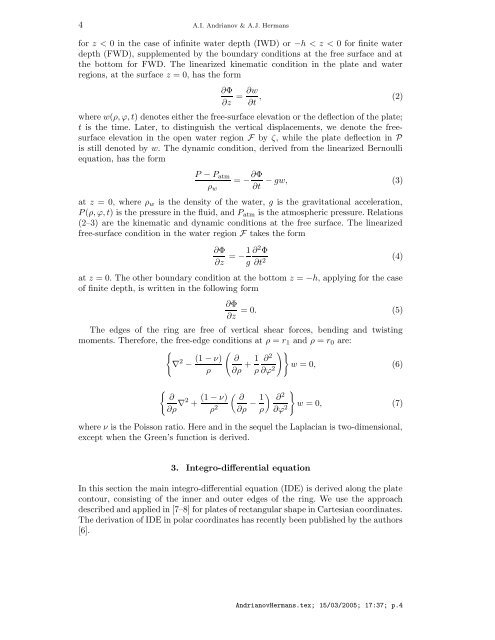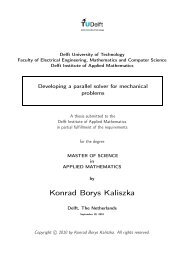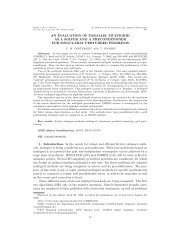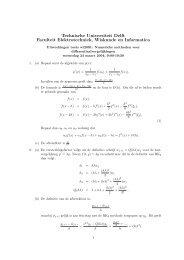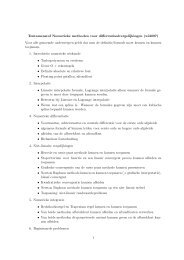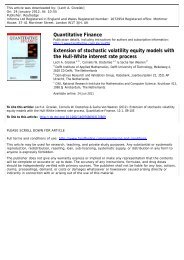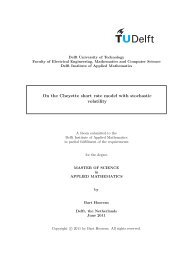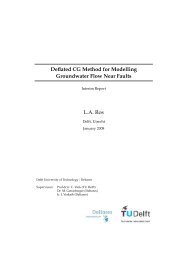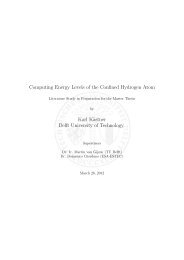Hydroelastic behavior of a floating ring-shaped plate
Hydroelastic behavior of a floating ring-shaped plate
Hydroelastic behavior of a floating ring-shaped plate
You also want an ePaper? Increase the reach of your titles
YUMPU automatically turns print PDFs into web optimized ePapers that Google loves.
4 A.I. Andrianov & A.J. Hermansfor z < 0 in the case <strong>of</strong> infinite water depth (IWD) or −h < z < 0 for finite waterdepth (FWD), supplemented by the boundary conditions at the free surface and atthe bottom for FWD. The linearized kinematic condition in the <strong>plate</strong> and waterregions, at the surface z = 0, has the form∂Φ∂z = ∂w∂t , (2)where w(ρ, ϕ, t) denotes either the free-surface elevation or the deflection <strong>of</strong> the <strong>plate</strong>;t is the time. Later, to distinguish the vertical displacements, we denote the freesurfaceelevation in the open water region F by ζ, while the <strong>plate</strong> deflection in Pis still denoted by w. The dynamic condition, derived from the linearized Bernoulliequation, has the formP − P atmρ w= − ∂Φ∂t− gw, (3)at z = 0, where ρ w is the density <strong>of</strong> the water, g is the gravitational acceleration,P (ρ, ϕ, t) is the pressure in the fluid, and P atm is the atmospheric pressure. Relations(2–3) are the kinematic and dynamic conditions at the free surface. The linearizedfree-surface condition in the water region F takes the form∂Φ∂z = −1 ∂ 2 Φg ∂t 2 (4)at z = 0. The other boundary condition at the bottom z = −h, applying for the case<strong>of</strong> finite depth, is written in the following form∂Φ∂z= 0. (5)The edges <strong>of</strong> the <strong>ring</strong> are free <strong>of</strong> vertical shear forces, bending and twistingmoments. Therefore, the free-edge conditions at ρ = r 1 and ρ = r 0 are:{(∇ 2 (1 − ν) ∂−ρ ∂ρ + 1 )}∂ 2ρ ∂ϕ 2 w = 0, (6){ ( ∂ (1 − ν) ∂∂ρ ∇2 +ρ 2 ∂ρ − 1 ) }∂2ρ ∂ϕ 2 w = 0, (7)where ν is the Poisson ratio. Here and in the sequel the Laplacian is two-dimensional,except when the Green’s function is derived.3. Integro-differential equationIn this section the main integro-differential equation (IDE) is derived along the <strong>plate</strong>contour, consisting <strong>of</strong> the inner and outer edges <strong>of</strong> the <strong>ring</strong>. We use the approachdescribed and applied in [7–8] for <strong>plate</strong>s <strong>of</strong> rectangular shape in Cartesian coordinates.The derivation <strong>of</strong> IDE in polar coordinates has recently been published by the authors[6].AndrianovHermans.tex; 15/03/2005; 17:37; p.4


